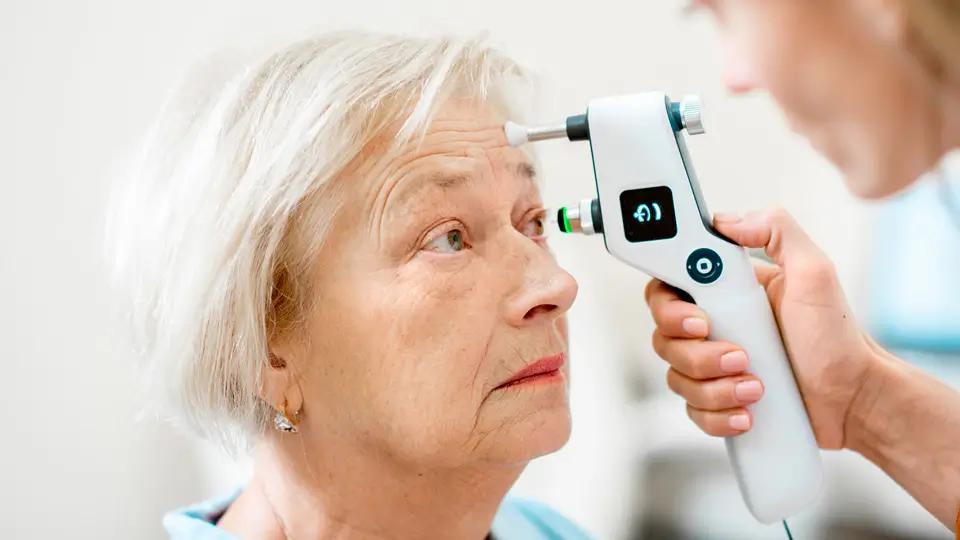People often call Glaucoma the “silent thief of sight” as its early stages do not exhibit any symptoms. Glaucoma refers to a range of eye conditions that cause harm to the optic nerve rendering blindness when unchecked. The major contributing factor for Glaucoma is the rise in fluid pressure inside one’s eye also known as Intra Ocular Pressure (IOP). Therefore, one’s vision of life must not be lost as a result of Glaucoma for diagnosis to be made at an early stage. IOP can be measured with the help of a diagnostic procedure called Tonometry, which plays a vital role in this disease. Here, we will learn more about what is Tonometry used for.
What is Tonometry?
Tonometry is a clinical process that is used to measure the pressure inside the eye which is known as intraocular pressure or IOP. High pressure inside the eye increases the risk of Glaucoma and Tonometry which is a process crucial for eye care services. This system involves checking IOPs so that eye specialists can diagnose Glaucoma or similar eye diseases early enough. There are different types of trigonometry, each with a particular method for carrying them out, though they all aim to measure IOP correctly.
Types of Tonometry
Tonometry is of different types which are as follows:
Goldmann applanation Tonometry
This is a process in which a small portion of the cornea is flattened using a slit lamp and tonometer. This type of tonometry is also considered a gold standard for measuring IOP. In this technique, the IOP measure calculates the force flattening the cornea. It is highly accurate and quite repetitively used in a clinical setting.
NCT
This is mostly known as the “air-puff test.” In this, a puff of air flattens the cornea. Quick, painless, and requiring no numbing eye drops, this method is ideal for preliminary screenings.
Tono-pen
This is basically a portable device that lightly touches the cornea of the eye and precisely measures IOP. It is also of help to patients with irregular corneas for whom other techniques cannot be used.
Perkins Tonometry
This is a portable version of the Goldmann Tonometer. This process is followed when a slit lamp is not available.
The role of Tonometry in diagnosing Glaucoma
Tonometry is crucial in the early detection and ongoing management of Glaucoma. Here’s how it plays a vital role:
Early detection
An increased IOP is one of the earliest signs to identify Glaucoma. Regular Tonometry helps to detect increased IOP before severe optic nerve damage occurs.
Monitoring disease progression
Regularly monitoring IOP is essential for patients diagnosed with this disease. Tonometry helps assess the effectiveness of treatment by providing the measurements of IOP. This will help to make necessary strategies that will help to prevent optic nerve damage.
Assessing risk in susceptible individuals
People with genes of Glaucoma, high myopia, and diabetes are at a higher risk of Glaucoma. Regular checkups of tonometry can help monitor it before this causes major damage to the optic nerve.
Postoperative care
After glaucoma surgery or other ocular procedures, Tonometry is used to ensure that the IOP remains safe, preventing complications and ensuring the success of the surgery.
Tonometry in comprehensive eye care
At Dr Jawahar Lal Rohatgi Smarak Netra Chikitsalaya, we integrate Tonometry into comprehensive eye care to provide our Tonometry with the best possible outcomes. Our approach includes:
Routine screenings
We recommend regular eye exams for all patients, including Tonometry, to detect any early changes in IOP. This proactive approach helps in catching Gl Tonometry in its initial stages.
Advanced diagnostic tools
Along with Tonometry, other diagnostic tools we use are optical coherence tomography, visual field testing, and gonio tonometry, which aid in the assessment of the health of the eye.
Personalized treatment plans
Depending on tonometry results and other diagnostic findings, we have treatment plans, and so each patient gets treated in accordance with how their needs dictate for optimum management of glaucoma and other ocular conditions.
Patient education
We believe in empowering our patients with knowledge. Our team will, therefore, educate you on the importance of regular eye exams, IOP’s role in Glaucoma, and how you can contribute to your eye health.
Conclusion
Tonometry is an essential instrument in diagnosing Glaucoma and its management. The accurate measurement of the IOP helps in the early detection of this disease, which is a silent thief of sight. It is only the proper measurement of the IOP that will avoid vision loss. Meet the glaucoma specialists of Dr. Jawaharlal Rohatgi Smarak Netra Chikitsalaya if you are suffering from the same condition. These doctors have a solemn duty to use advanced technology in providing comprehensive eye care and ensuring that the patient’s sight is protected. Therefore, ocular health is something very crucial to maintain together with tonometry and regular eye exams in order to prevent glaucoma.





 Call Us Now
Call Us Now
Leave a Reply